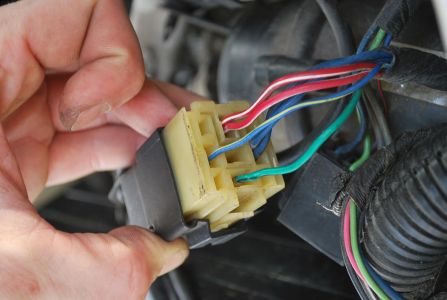Your donation is appreciated, but once is enough. Thank you.
The relay uses a tiny current to turn a large current on and off. The tiny current through the coil inside the relay creates a magnetic field that pulls on the switch contact.
For the little current to flow through the coil of wire, there must be a difference in voltage between the two wires, in this case, 12 volts that comes from the ignition switch when it is turned to "run", and 0 volts which is ground. The ground is normally supplied by the Engine Computer, but it can also be supplied by you with a jumper wire. When the ground wire is "open", meaning disconnected, the voltage that comes in on the blue wire will be seen on the other end of the coil which is the blue / yellow wire. There is a much more involved way to explain this electrical theory, but that was part of my 180 hour long Automotive Electrical class. There is a faster way to describe what happens.
There has to be a "load" in the circuit to prevent a short circuit or excessive current. The load is resistance to current flow, and could be a motor, a light bulb, or in this case, a wound-up piece of wire that is so long, it has a lot of resistance.
I can compare anything electrical that you can't see to something with water, that you can visualize. If you imagine a garden hose hooked to the faucet on your house, and a pressure gauge at the faucet that reads 12 psi, you have to use up that 12 psi somewhere or it will appear at the end of the hose by the closed nozzle. With the nozzle open, there will still be 12 psi at the faucet, but 0 psi when the water falls on the ground. The only resistance that limited how much water would flow, (current), is the resistance, (diameter) of the hose. If you squeeze the hose with your fist, you add resistance which decreases current flow. The water flow slows down, but you still have 0 psi when the water hits the ground. Most of the pressure was "dropped" where you squeezed the hose. Now, if you keep your hand there, but someone closes the nozzle, what happens? Current flow stops, and you would measure 12 psi at the end of the hose. That 12 psi, when no current is flowing, is the 12 volts you are reading on the blue / yellow wire.
The pressure is the same on both sides of your hand in the hose. When the pressure is the same in both places, water will not flow from one place to another, (no current flow). When voltage is the same in two places, electricity, (current) will not flow either. When current does flow in a wire, it sets up a magnetic field. Winding the wire into many loops to create a coil intensifies the magnetic field. Think of that coil as your hand squeezing the hose.
When the blue / yellow wire is grounded, (opening the nozzle), the difference in the two voltages causes electrical current to flow. That current sets up the magnetic field in the coil so he can do his thing. Normally that blue / yellow wire is grounded by the Engine Computer. When it does, the magnetic field in the coil pulls the lever to turn on the contact that passes the larger current, in this case, to the fuel pump.
The two larger wires on the relay handle the larger fuel pump current. The contacts in the relay are just a switch, but rather than using your fingers to flip the switch, the coil's magnetic field does it.
Relays make a real convenient way to break a circuit in half for testing. Before I loose complete track of where we were, by grounding the blue / yellow wire, you are doing the same thing the Engine Computer is supposed to do. You should hear and feel the relay click, and the fuel pump should run. If it does, that proves, without any further or involved testing, that the pump, relay, large wires, and the fuse for that circuit are all good. This applies to any circuit with a relay.
Most Chrysler cars from this era feed the injector(s), ignition coil, oxygen sensor heaters, alternator field, AND the fuel pump from the Automatic Shutdown (ASD) relay. I don't know why, but in your car, they use a separate relay for the fuel pump. Both relay coils are connected in parallel, meaning they both get the same 12 volts from the ignition switch on one terminal and they are both grounded by the same terminal in the computer. When you ground the blue / yellow wire, both relays should click.
Part of the confusion could be due to how the switching is done for the relay's coil. We normally think of turning on a switch and sending the voltage TO something, such as the light in your house. There has to be a complete path for the current to get back to the battery, or whatever source it came from. In this case, with the relay, the switch is interrupting the return path, (ground circuit) instead of the feed path. A common term for this is "ground side switching" or "ground controlled". Feed side switching would be turning off the faucet at your house. No pressure in the hose / no voltage to the relay. Ground side switching would be closing the nozzle. Pressure in the hose / voltage at the relay, but no current flow.
Hope that all made sense. I'll have to reread some of our previous replies to each other to remeber where we were, but in the meantime, see what happens when you ground the blue / yellow wire.
Caradiodoc
Sunday, March 21st, 2010 AT 11:38 PM




